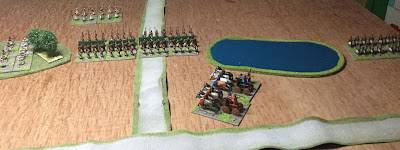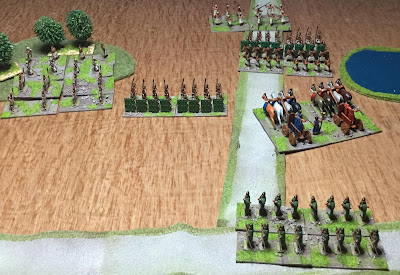WW2
Am going to try him very soon with the airfix WW2 game as it seems ideally suited to my purpose, simple game, easy to set up, quick to play. Then thought I would try Rapid Fire. This is the most developed of the 'old fashioned' WW2 games. No 3C complexity, the figures / models act as toy soldiers / model tanks rather than as a representation of a simulated unit with lots of abstractions, seems ideal for a child's thought processes. Then I thought I might try him on Blitzkrieg Commander - mainly as it is a game that I enjoy. Also, it introduces complexity in command - but not to much. Its throw dice below a certain number to get to do stuff, with the number getting smaller each time is fairly intuitive. The combat resolution is fairly straight forward as well.Ancients
Building on the success of the One Hour Wargames games DBA seems the obvious next step. Twice the amount of maneuver units, with simple command and control rules and some added complexity in combat resolution. A step forward from OHW and worth digging out my old V2 set. Who knows, may inspire me to by the V3 set. If he can deal with DBA I can then try Art de la Guerre rules. My ancient rules of choice at the moment and very firmly a DB inspired set. These may be a step to far at the moment but lets see how he gets on with DBA and then have another look.Dark Ages
Am going to give him a go at SAGA at some point. This could go either way, the battle board may just overwhelm him and leave him confused. Or he may get drawn into trying to figure it out in that slightly obsessive fashion that children can summon up for a topic and end up kicking my arse all around the 11th century - a suck it and see thing I think.
Air Combat
Wings of Glory just seems like it works for children so has to be tried. Am also going to try X wing as well. This is because, well, Star Wars and he is a child so that obviously works. Will also be interesting to compare it to WoG - which so obviously inspired it and see which set works better.Horse and Musket
Was going to try playing Charge! as the basic game seems like an excellent starting point for the era and I really do feel that I should play the Blasthof Bridge Scenario at least once in my lifetime as an homage to the giants whose shoulders we all stand on. If that works well, then there are the advanced rules to naturally advance onto. Am considering expanding this out into developing an Imaginations campaign together with the boy - might be a nice project for the years. I was thinking of using the HaT SYW figures as the basis for the armies but can't seem to find them for sale - can anyone confirm if they are out of production or not?
Naval Games
As I play em thought I might as well try em with the boy. For the ironclads will probably use the set written by a club member - these are a little more crunchy than may be advisable for an introductory set. Can anyone recommend a 'starter' set of rules for ironclads? Must cover more than just the ACW mind. For WW2 was thinking of giving GQ3 a go - as they are my set of choice. They can be a little complex but the game is designed well so for shooting all you have to do is look at one table, so it might be doable. Again, any recommendations for a good 'intro' set?Fantasy
The boy is into Lord of the Rings so fantasy is probably in order. Have got a copy of the LoTR Strategy Tactical Skirmish FIghty Battle Game or whatever they call it. I do remember hearing very good things about it as a set of rules though - which is probably why I got a copy, never got around to playing them mind, now is my chance it seems. Have also acquired a Dungeon Saga from Mantic games - it seems a well thought out relativly simple dungeon crawl game so seems in order to play with the boy. If Warhammer was still Warhammer I might have tried him on that but what with the new Age of Sigmar, not sure I can be bothered to learn new names for Elves and Dwarves and such. Mind you, free rules are a good price pointto try out I suppose. Are there any other rules worth trying out?Sci Fi
This is easy to sum up with 'Space Hulk'. I brought a set a few years ago when GW did their 'one off, never to be repeated, last chance to buy, limited edition, you will not see its like again' release. This was done on a whim powered by happy memories of playing Space Hulk for many an hour a long time ago. I was in no way disappointed, a well produced high quality game that retained the original simplicity. Have not played it that much mind - maybe time to crack it out. If the boy enjoys it I may then summon up the energy to give 40k a go, or I may not........
Gladiators
Do not own any figures, or know anything about rules, but well, Gladiators are cool and the boy has already read books about them. Any recommendations for rules and figures? Figure wise am looking more for cheap and sturdy rather than exquisite and expensive as well, young hands......
Cowboys
Again, do not own any rules or figures at the moment. However, seems like a fun period for a child. I did consider the fact that cowboys are just not a thing for children anymore - at least round my neck of the woods. However, this just means that I get to watch some cool cowboy films with my children and then play the games - whats not to love about that? I hear good things about Dead Mans Hand as a simple and fast set of rules - would they be suitable? Any other recommendations?Pirates
Still most definitely a thing for children (and adults come to that). Again, no idea on rules or figures - any recommendations?
The above list seems like enough to keep us going for a year (or two). But I am still open to recommendations. Am especially interested in recommendations for simple boardgames like the airfix one mentioned for WW2. Something simple, cheap(ish) and good to go right out of the box is what i am looking for at the moment.











































